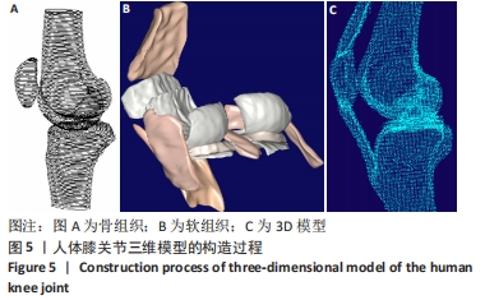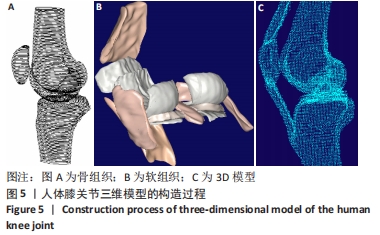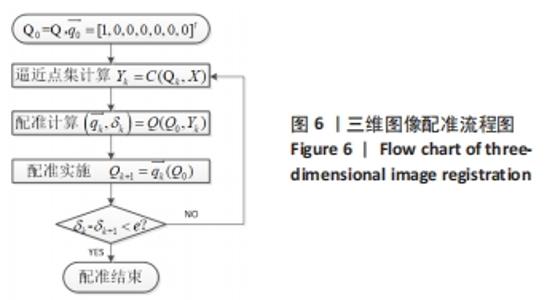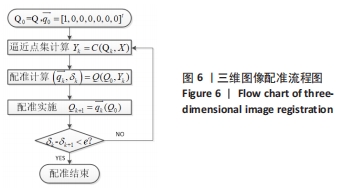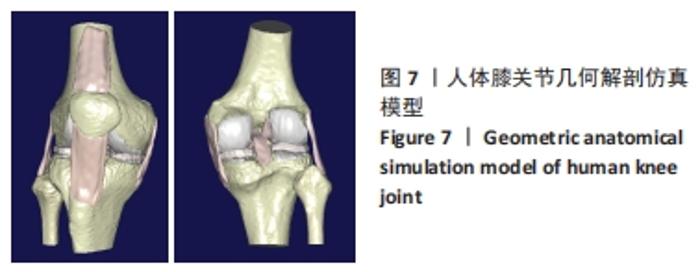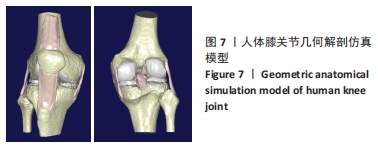[1] 栾英艳,王迎,何蕊. 新工科背景下工程图学课程改革研究[J]. 图学学报,2020,41(1):164-168.
[2] 张芳兰,陈瑞营,邵帅,等. 基于参数化逆向建模的踝足矫形器设计[J]. 图学学报,2020,41(1):141-147.
[3] ADOUNI M, FAISAL TR, GAITH M, et al. A multiscale synthesis characterizing acute cartilage failure _under an aggregate tibiofemoral joint loading. Biomech Model Mechanobiol. 2019;18(6): 1563-1575.
[4] SAEIDI M, GUBAUA JE, KELLY P, et al. The infuence of an extra‑articular implant on bone remodelling of the knee joint. Biomech Model Mechanobiol. 2020;19(1):37-46.
[5] 骆健,王立华,王涛.不同材料赋值方法下踝关节三维有限元模型的应力及位移变化[J]. 中国组织工程研究,2019,23(18):2822-2826.
[6] 刘韵婷,郭辉,黄将诚. 基于UG与ADAMS的人体下肢骨骼肌建模及仿真[J].中国组织工程研究,2018,22(11):1719-1724.
[7] 余华,李少星,赵长义.胫骨远端关节面缺损有限元模型的生物力学分析[J].中国组织工程研究,2013,17(43):7571-7580.
[8] HE Y, LI T, GE R, et al. Few-shot Learning for Deformable Medical Image Registration with Perception-Correspondence Decoupling and Reverse Teaching. IEEE J Biomed Health Inform. 2022;26(3):1177-1187.
[9] 麦永锋,孙启昌.基于DRR及相似性测度的2D-3D医学图像配准算法[J]. 北京生物医学工程,2021,40(3):263-272.
[10] 劳峥,樊文慧. 医学图像处理MIM软件和Velocity软件在弹性模体中形变配准精度的比较研究[J]. 中国医学装备,2021,18(6):47-51.
[11] ZHANG J, LIU F, YU X, et al. A 3D medical image registration method based on multi-scale feature fusion. J Phys Conf Series. 2021. doi: 10.1088/1742-6596/1948/1/012057
[12] LUO Y, CAO W, HE Z, et al. Deformable adversarial registration network with multiple loss constraints. Comput Med Imaging Graph. 2021;91: 101931.
[13] 宋枭,朱家明,徐婷宜.基于B样条仿射和GANs的医学图像配准[J]. 无线电工程,2021,51(6):433-439.
[14] Marieswaran M, Sikidar A, Goel A, et al. An extended OpenSim knee model for analysis of strains of connective tissues. BioMed Eng OnLine. 2018;17:42.
[15] LENHART RL. Prediction and Validation of Load-Dependent Behavior of the Tibiofemoral and Patellofemoral Joints During Movement. Ann Biomed Eng. 2015;43(11):2675-2685.
[16] 顾冬云,戴尅戎,胡鑫.髋臼骨关节面的曲面形态分析[J].生物医学工程学,2004,21(5):721-726.
[17] 王建平,闫池辉,张盼盼,等.基于Neo-Hookean本构模型的人体膝关节韧带力学性能测试分析[J]. 上海理工大学学报, 2017,39(6): 580-585.
[18] WANG J, YANG Y, GUO D, et al. The Effect of Patellar Tendon Release on the Characteristics of Patellofemoral Joint Squat Movement: A Simulation Analysis. Appl Sci. 2019;(9):4301.
[19] CHEN E, ELLIS RE, BRYANT JT, et al. A computational model of postoperative knee kinematics. Med Image Anal. 2001;(5):317-330.
[20] FEIKES JD, O’CONNOR JJ, ZAVATSKY AB. A constraint-based approach to modelling the mobility of the human knee joint. J Biomch. 2003; 36:125-129.
[21] 王建平,赵烜,胡海,等. 基于MATLAB的人体膝关节运动捕捉测量与分析[J]. 河南理工大学学报(自然科学版),2020,39(3):86-93.
[22] WANG J, GUO D, WANG S, et al. Structural stability of a polyetheretherketone femoral component—A 3D finite element simulation. Clin Biomech. 2019;70:153-157.
[23] WANG JP, WANG SH, WANG YQ, et al. A data process of human knee joint kinematics obtained by motion-capture measurement. BMC Med Inform Decis Mak. 2021;21(1):121-129.
[24] 李宏伟,刘峰, 个体化全膝关节置换骨肌多体动力学模型的适用性评估[J]. 机械设计与制造工程,2021,50(5):6-10.
[25] 高辉,王晨艳,不同屈曲状态下固定轴和移动轴膝关节胫-股关节的生物力学变化[J].太原理工大学学报,2021,52(1):144-150.
[26] WANG J, TAO K, LI H, et al. Modelling and analysis on biomechanical dynamic characteristics of knee flexion movement under squating. Sci World J. 2014;14:321080.
[27] 王建平,符龙,张雁儒,等.正常膝关节和人工膝关节髌股关节高屈曲运动特性及其比较分析[J]. 中国临床解剖学杂志,2016,34(4): 432-438.
[28] 王建平,梁军,张雁儒,等.人体膝关节股胫关节运动特性分析[J].中国临床解剖学杂志,2017, 35(1):62-68.
[29] 叶铭,于力牛,王成焘.目标组织轮廓的三次非均匀B样条逼近[J]. 上海交通大学学报,2003,37(5):729-732.
[30] BLEMKER SS, ASAKAWA DS, GOLD GE, et al. Image-based musculoskeletal modeling: Applications, advances, and future opportunities. J Magn Reson Imaging. 2007;25(2):441-451.
[31] LI G, LOOPEZ O. Reliability of a 3D Finite Element Model Constructed Using Magnetic Resonance Images of a Knee for Joint Contact Stress Analysis. in 23rd Proceedings of the American Society of Biomechanics. 1999; Pittsburgh, PA.
[32] 杭声琪,张文韬.基于CT和MRI膝关节有限元模型建立与不同载荷下生物力学特性分析[J].中国医学物理学杂志,2021,38(3):370-374.
[33] NIEMAN K, RENSING BJ, VAN GEUNS RJ, et al. Usefulness of multislice computed tomography for detecting obstructive coronary artery disease. Am J Cardiol. 2002;89(8):913-918.
[34] 胡小新, 陈时洪. 螺旋CT三维重建成像在骨关节外伤中的临床应用价值探讨[J]. 中华放射学杂志,2002,36(8):758-760.
[35] 赖鹏, 汪元美. 参数设置对多层螺旋CT三维重建误差的影响[J]. 中国医疗器械杂志,2003,27(5):317-320.
[36] MCCOLLOUGH CH, ZINK FE. Performance evaluation of a multi-slice CT system. Med Phys. 1999;26(11):2223-2230.
[37] VICECONTI M, ZANNONI C, TESTI D. CT data sets surface extraction for biomechanical modeling of long bones. Comput Methods Programs Biomed. 1999;59(3):159-166.
[38] 王建平, 吴海山, 王成焘. 人体膝关节动态有限元模型及其在TKR中的应用[J]. 医用生物力学,2009,24(5):333-337.
[39] HILDEBOLT CF, VANNIER MW, KNAPP RH. Validation study of skull three-dimensional computerized tomography measurements. Am J Phys Anthropol. 1990;82(3):283-294.
[40] HUANG YC. A fast error comparison method for massive STL data. Adv Eng Software. 2008;39(12):962-973.
[41] 宋志刚. 三维有限元模型在发育性髋关节发育不良并发股骨头坏死中的应用[J]. 中国医药导报,2021,18(27):43-46.
[42] 柴岗,张艳,刘伟,等. 基于Micro-CT的三维打印组织工程骨建模技术[J]. 组织工程与重建外科杂志,2007,3(5):247-248,270.
[43] 蒋利锋,章淼锋,朱苏南,等. 活动平台单髁假体的三维有限元模型建立及受力分析[J]. 生物骨科材料与临床研究,2015,12(2):69-72.
[44] 周广全,何伟,庞智晖,等. 临床研究基于参数化联合建模法建立膝关节单髁置换三维有限元模型的研究[J]. 广东医学,2012,33(3): 328-330.
[45] 王臻,滕勇,李涤尘,等. 基于快速成型的个体化人工半膝关节的研制--计算机辅助设计与制造[J]. 中国修复重建外科杂志,2004, 18(5):347-351.
[46] 张银婷,彭鳒侨. 基于MRI图像的计算机膝关节建模新思路[J]. 中华关节外科杂志(电子版),2018,12(6):37-41.
|
